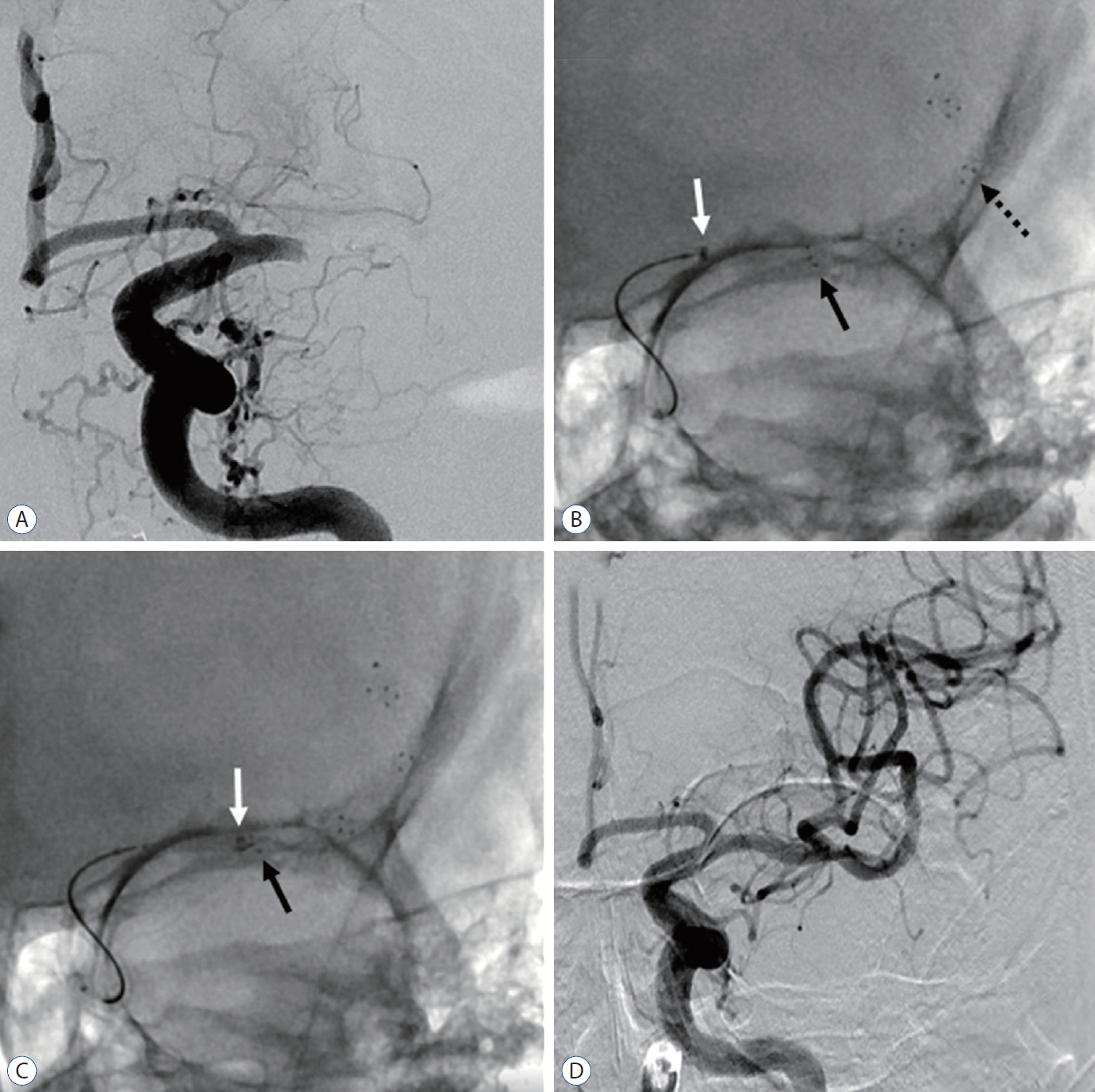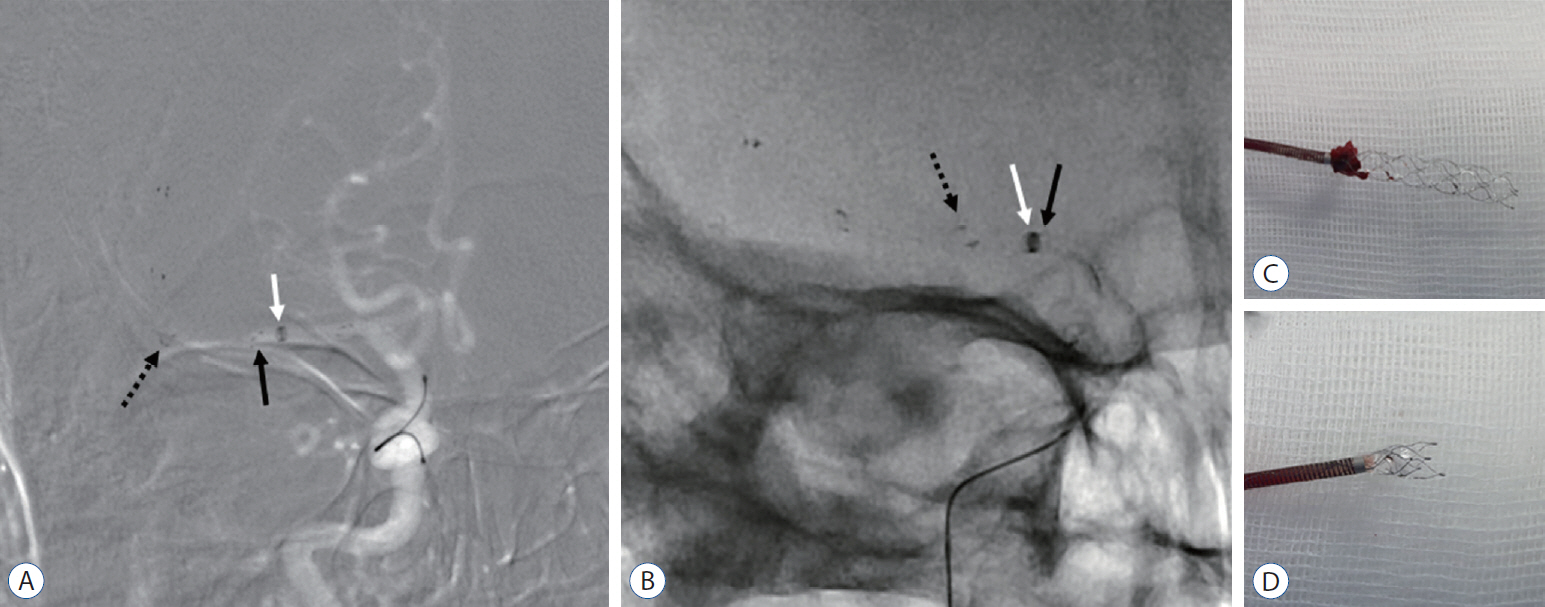J Korean Neurosurg Soc.
2021 Jan;64(1):30-38. 10.3340/jkns.2020.0046.
Effectiveness and Technical Considerations of Solitaire Platinum 4×40 mm Stent Retriever in Mechanical Thrombectomy with Solumbra Technique
- Affiliations
-
- 1Department of Neurosurgery, St. Vincent’s Hospital, College of Medicine, The Catholic University of Korea, Suwon, Korea
- 2Department of Neurosurgery, Hangang Sacred Heart Hospital, College of Medicine, Hallym University, Seoul, Korea
- KMID: 2510757
- DOI: http://doi.org/10.3340/jkns.2020.0046
Abstract
Objective
: The Solitaire Platinum 4×40 mm stent retriever contains radiopaque markers with a long length. We evaluated the effect of Solitaire Platinum 4×40 mm stent retriever in Solumbra technique thrombectomy, and compared it with shorter Solitaire stent retrievers.
Methods
: A total of 70 patients who underwent Solumbra technique thrombectomy with equal diameter (4 mm) and different length (40 vs. 20 mm) Solitaire stent retrievers were divided into two groups : the Solitaire Platinum 4×40 mm stent (4×40) group and the Solitaire FR 4×20 mm stent or Solitaire Platinum 4×20 mm stent (4×20) group. The clinical outcomes, Thrombolysis in Cerebral Infarction score, the first pass reperfusion status, and complications were evaluated and compared between the two groups. Multivariate analysis was performed to evaluate the predictive factors for reperfusion and complete reperfusion from the first pass.
Results
: Higher first-pass reperfusion and complete reperfusion were achieved in the 4×40 group (68.0% and 48.0%) than in the 4×20 group (46.7% and 33.3%; p=0.004 and 0.007, respectively). In multivariate analysis, radiopaque device and longer stent retriever were correlated with first-pass reperfusion (p=0.014 and 0.008, respectively) and first-pass complete reperfusion (p=0.022 and 0.012, respectively).
Conclusion
: Our study demonstrated the usefulness of the Solitaire Platinum 4×40 mm stent retriever, which led to higher firstpass reperfusion and complete reperfusion rates than the Solitaire FR 4×20 mm stent or the Solitaire Platinum 4×20 mm stent, especially in Solumbra technique thrombectomy.
Keyword
Figure
Cited by 2 articles
-
Effectiveness of Anchoring with Balloon Guide Catheter and Stent Retriever in Difficult Mechanical Thrombectomy for Large Vessel Occlusion
Ho Jun Yi, Bum-Tae Kim, Dong-Sung Shin
J Korean Neurosurg Soc. 2022;65(4):514-522. doi: 10.3340/jkns.2021.0158.Undeflatable balloon guide catheter (BGC) during endovascular procedure: Rescue strategy
Hyungkyu Lee, Taejoon Park, Jinwook Baek, Seonghwan Kim, Sangpyung Lee, Kyoungsoo Ryou
J Cerebrovasc Endovasc Neurosurg. 2022;24(4):372-379. doi: 10.7461/jcen.2022.E2021.10.005.
Reference
-
References
1. Amarenco P, Bogousslavsky J, Caplan LR, Donnan GA, Hennerici MG. Classification of stroke subtypes. Cerebrovasc Dis. 27:493–501. 2009.
Article2. Berkhemer OA, Fransen PS, Beumer D, van den Berg LA, Lingsma HF, Yoo AJ, et al. A randomized trial of intraarterial treatment for acute schemic stroke. N Engl J Med. 372:11–20. 2015.3. Bourcier R, Saleme S, Labreuche J, Mazighi M, Fahed R, Blanc R, et al. More than three passes of stent retriever is an independent predictor of parenchymal hematoma in acute ischemic stroke. J Neurointerv Surg. 11:625–629. 2019.
Article4. Bracard S, Ducrocq X, Mas JL, Soudant M, Oppenheim C, Moulin T, et al. Mechanical thrombectomy after intravenous alteplase versus alteplase alone after stroke (THRACE): a randomised controlled trial. Lancet Neurol. 15:1138–1147. 2016.
Article5. Campbell BC, Mitchell PJ, Kleinig TJ, Dewey HM, Churilov L, Yassi N, et al. Endovascular therapy for ischemic stroke with perfusion-imaging selection. N Engl J Med. 372:1009–1018. 2015.
Article6. Dargazanli C, Consoli A, Barral M, Labreuche J, Redjem H, Ciccio G, et al. Impact of modified TICI 3 versus modified TICI 2b reperfusion score to predict good outcome following endovascular therapy. AJNR Am J Neuroradiol. 38:90–96. 2017.
Article7. Dargazanli C, Fahed R, Blanc R, Gory B, Labreuche J, Duhamel A, et al. Modified thrombolysis in cerebral infarction 2C/thrombolysis in cerebral infarction 3 reperfusion should be the aim of mechanical thrombectomy: insights from the ASTER trial (contact aspiration versus stent retriever for successful revascularization). Stroke. 49:1189–1196. 2018.
Article8. Deshaies EM. Tri-axial system using the Solitaire-FR and Penumbra Aspiration Microcatheter for acute mechanical thrombectomy. J Clin Neurosci. 20:1303–1305. 2013.
Article9. Goyal M, Demchuk AM, Menon BK, Eesa M, Rempel JL, Thornton J, et al. Randomized assessment of rapid endovascular treatment of ischemic stroke. N Engl J Med. 372:1019–1030. 2015.
Article10. Goyal M, Menon BK, van Zwam WH, Dippel DW, Mitchell PJ, Demchuk AM, et al. Endovascular thrombectomy after large-vessel ischaemic stroke: a meta-analysis of individual patient data from five randomised trials. Lancet. 387:1723–1731. 2016.
Article11. Hacke W, Kaste M, Bluhmki E, Brozman M, Dávalos A, Guidetti D, et al. Thrombolysis with alteplase 3 to 4.5 hours after acute ischemic stroke. N Engl J Med. 359:1317–1329. 2008.
Article12. Haussen DC, Al-Bayati AR, Grossberg JA, Bouslama M, Barreira C, Bianchi N, et al. Longer stent retrievers enhance thrombectomy performance in acute stroke. J Neurointerv Surg. 11:6–8. 2019.
Article13. Haussen DC, Lima A, Nogueira RG. The Trevo XP 3×20 mm retriever ('Baby Trevo') for the treatment of distal intracranial occlusions. J Neurointerv Surg. 8:295–299. 2016.
Article14. Hesse AC, Behme D, Kemmling A, Zapf A, Große Hokamp N, Frischmuth I, et al. Comparing different thrombectomy techniques in five large-volume centers: a 'real world' observational study. J Neurointerv Surg. 10:525–529. 2018.
Article15. Hopf-Jensen S, Preiß M, Marques L, Lehrke S, Schattschneider J, Stolze H, et al. Impact and effectiveness of dual aspiration technique in stent-assisted mechanical thrombectomy: recent improvements in acute stroke management. Cardiovasc Intervent Radiol. 39:1620–1628. 2016.
Article16. Humphries W, Hoit D, Doss VT, Elijovich L, Frei D, Loy D, et al. Distal aspiration with retrievable stent assisted thrombectomy for the treatment of acute ischemic stroke. J Neurointerv Surg. 7:90–94. 2015.
Article17. Jovin TG, Chamorro A, Cobo E, de Miquel MA, Molina CA, Rovira A, et al. Thrombectomy within 8 hours after symptom onset in ischemic stroke. N Engl J Med. 372:2296–2306. 2015.
Article18. Kabbasch C, Mpotsaris A, Chang DH, Hiß S, Dorn F, Behme D, et al. Mechanical thrombectomy with the Trevo ProVue device in ischemic stroke patients: does improved visibility translate into a clinical benefit? J Neurointerv Surg. 8:778–782. 2016.
Article19. Kaesmacher J, Maegerlein C, Zibold F, Wunderlich S, Zimmer C, Friedrich B. Improving mTICI2b reperfusion to mTICI2c/3 reperfusions: a retrospective observational study assessing technical feasibility, safety and clinical efficacy. Eur Radiol. 28:274–282. 2018.
Article20. Kang DH, Kim YW, Hwang YH, Park J, Hwang JH, Kim YS. Switching strategy for mechanical thrombectomy of acute large vessel occlusion in the anterior circulation. Stroke. 44:3577–3579. 2013.
Article21. Maegerlein C, Berndt MT, Mönch S, Kreiser K, Boeckh-Behrens T, Lehm M, et al. Further development of combined techniques using stent retrievers, aspiration catheters and BGC : the PROTECTPLUS technique. Clin Neuroradiol. 30:59–65. 2020.
Article22. Maegerlein C, Mönch S, Boeckh-Behrens T, Lehm M, Hedderich DM, Berndt MT, et al. PROTECT: PRoximal balloon Occlusion TogEther with direCt Thrombus aspiration during stent retriever thrombectomy - evaluation of a double embolic protection approach in endovascular stroke treatment. J Neurointerv Surg. 10:751–755. 2018.
Article23. Maus V, Behme D, Kabbasch C, Borggrefe J, Tsogkas I, Nikoubashman O, et al. Maximizing first-pass complete reperfusion with SAVE. Clin Neuroradiol. 28:327–338. 2018.
Article24. Maus V, Brehm A, Tsogkas I, Henkel S, Psychogios MN. Stent retriever placement in embolectomy: the choice of the post-bifurcational trunk influences the first-pass reperfusion result in M1 occlusions. J Neurointerv Surg. 11:237–240. 2019.
Article25. Mizokami T, Uwatoko T, Matsumoto K, Ooya Y, Hashimoto G, Koguchi M, et al. Aspiration Catheter Reach to Thrombus (ART) sign in combined technique for mechanical thrombectomy: impact for first-pass complete reperfusion. J Stroke Cerebrovasc Dis. 28:104301. 2019.
Article26. Nikoubashman O, Alt JP, Nikoubashman A, Büsen M, Heringer S, Brockmann C, et al. Optimizing endovascular stroke treatment: removing the microcatheter before clot retrieval with stent-retrievers increases aspiration flow. J Neurointerv Surg. 9:459–462. 2017.
Article27. Pérez MA, Miloslavski E, Fischer S, Bäzner H, Henkes H. Intracranial thrombectomy using the Solitaire stent: a historical vignette. J Neurointerv Surg. 4:e32. 2012.28. Pfaff J, Rohde S, Engelhorn T, Doerfler A, Bendszus M, Möhlenbruch MA. Mechanical thrombectomy using the new Solitaire™ Platinum stent-retriever : reperfusion results, complication rates and early neurological outcom. Clin Neuroradiol. 29:311–319. 2019.
Article29. Saver JL, Goyal M, Bonafe A, Diener HC, Levy EI, Pereira VM, et al. Stent-retriever thrombectomy after intravenous t-PA vs. t-PA alone in stroke. N Engl J Med. 372:2285–2295. 2015.
Article30. Turk AS, Frei D, Fiorella D, Mocco J, Baxter B, Siddiqui A, et al. ADAPT FAST study: a direct aspiration first pass technique for acute stroke thrombectomy. J Neurointerv Surg. 6:260–264. 2014.
Article31. Yang D, Hao Y, Zi W, Wang H, Zheng D, Li H, et al. Effect of retrievable stent size on endovascular treatment of acute ischemic stroke: a multicenter study. AJNR Am J Neuroradiol. 38:1586–1593. 2017.
Article32. Yi HJ, Lee DH, Sung JH. Clinical usefulness of waiting after stent deployment in mechanical thrombectomy: effect of the clot integration. World Neurosurg. 119:e87–e93. 2018.
Article33. Yi HJ, Sung JH, Lee DH, Hong JT, Lee SW. Single-center experience of mechanical thrombectomy with the Trevo XP ProVue 6 × 25 mm stent retriever in middle cerebral artery occlusion: comparison with Trevo XP ProVue 4 × 20 mm. World Neurosurg. 107:649–656. 2017.
Article34. Zaidat OO, Castonguay AC, Linfante I, Gupta R, Martin CO, Holloway WE, et al. First pass effect: a new measure for stroke thrombectomy devices. Stroke. 49:660–666. 2018.
- Full Text Links
- Actions
-
Cited
- CITED
-
- Close
- Share
- Similar articles
-
- Endovascular Stroke Therapy Focused on Stent Retriever Thrombectomy and Direct Clot Aspiration: Historical Review and Modern Application
- Mechanical Thrombectomy Using the Solitaire FR system for Occlusion of the Top of the Basilar Artery: Intentional Detachment of the Device after Partial Retrieval
- Treatment of the Superior Sagittal Sinus Thrombosis with the Mechanical Thrombectomy Using Stent-Retriever Device
- Unexpected Detachment of Solitaire Stents during Mechanical Thrombectomy
- Adjuvant Tirofiban Injection Through Deployed Solitaire Stent As a Rescue Technique After failed Mechanical Thrombectomy in Acute Stroke



